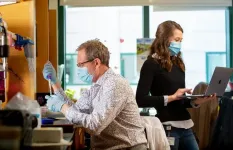3D holographic head-up display could improve road safety
2021-04-26
(Press-News.org) Researchers have developed the first LiDAR-based augmented reality head-up display for use in vehicles. Tests on a prototype version of the technology suggest that it could improve road safety by 'seeing through' objects to alert of potential hazards without distracting the driver.
The technology, developed by researchers from the University of Cambridge, the University of Oxford and University College London (UCL), is based on LiDAR (light detection and ranging), and uses LiDAR data to create ultra high-definition holographic representations of road objects which are beamed directly to the driver's eyes, instead of 2D windscreen projections used in most head-up displays.
While the technology has not yet been tested in a car, early tests, based on data collected from a busy street in central London, showed that the holographic images appear in the driver's field of view according to their actual position, creating an augmented reality. This could be particularly useful where objects such as road signs are hidden by large trees or trucks, for example, allowing the driver to 'see through' visual obstructions. The results are reported in the journal Optics Express.
"Head-up displays are being incorporated into connected vehicles, and usually project information such as speed or fuel levels directly onto the windscreen in front of the driver, who must keep their eyes on the road," said lead author Jana Skirnewskaja, a PhD candidate from Cambridge's Department of Engineering. "However, we wanted to go a step further by representing real objects in as panoramic 3D projections."
Skirnewskaja and her colleagues based their system on LiDAR, a remote sensing method which works by sending out a laser pulse to measure the distance between the scanner and an object. LiDAR is commonly used in agriculture, archaeology and geography, but it is also being trialled in autonomous vehicles for obstacle detection.
Using LiDAR, the researchers scanned Malet Street, a busy street on the UCL campus in central London. Co-author Phil Wilkes, a geographer who normally uses LiDAR to scan tropical forests, scanned the whole street using a technique called terrestrial laser scanning. Millions of pulses were sent out from multiple positions along Malet Street. The LiDAR data was then combined with point cloud data, building up a 3D model.
"This way, we can stitch the scans together, building a whole scene, which doesn't only capture trees, but cars, trucks, people, signs, and everything else you would see on a typical city street," said Wilkes. "Although the data we captured was from a stationary platform, it's similar to the sensors that will be in the next generation of autonomous or semi-autonomous vehicles."
When the 3D model of Malet St was completed, the researchers then transformed various objects on the street into holographic projections. The LiDAR data, in the form of point clouds, was processed by separation algorithms to identify and extract the target objects. Another algorithm was used to convert the target objects into computer-generated diffraction patterns. These data points were implemented into the optical setup to project 3D holographic objects into the driver's field of view.
The optical setup is capable of projecting multiple layers of holograms with the help of advanced algorithms. The holographic projection can appear at different sizes and is aligned with the position of the represented real object on the street. For example, a hidden street sign would appear as a holographic projection relative to its actual position behind the obstruction, acting as an alert mechanism.
In future, the researchers hope to refine their system by personalising the layout of the head-up displays and have created an algorithm capable of projecting several layers of different objects. These layered holograms can be freely arranged in the driver's vision space. For example, in the first layer, a traffic sign at a further distance can be projected at a smaller size. In the second layer, a warning sign at a closer distance can be displayed at a larger size.
"This layering technique provides an augmented reality experience and alerts the driver in a natural way," said Skirnewskaja. "Every individual may have different preferences for their display options. For instance, the driver's vital health signs could be projected in a desired location of the head-up display.
"Panoramic holographic projections could be a valuable addition to existing safety measures by showing road objects in real time. Holograms act to alert the driver but are not a distraction."
The researchers are now working to miniaturise the optical components used in their holographic setup so they can fit into a car. Once the setup is complete, vehicle tests on public roads in Cambridge will be carried out.
INFORMATION:
Skirnewskaja is a PhD candidate at the EPSRC Centre for Doctoral Training (CDT) in Connected Electronic and Photonic Systems, a joint centre with the University of Cambridge and UCL. She also is a fellow of the Foundation of German Business (SDW).
ELSE PRESS RELEASES FROM THIS DATE:
2021-04-24
Patients receiving an implantable cardioverter defibrillator (ICD) should be regularly screened for anxiety and depression, according to research presented at EHRA 2021, an online scientific congress of the European Society of Cardiology (ESC).1
Study author Professor Susanne Pedersen of Odense University Hospital, Denmark said: "Most patients adapt well to living with an ICD. For others it completely changes their life, with worries about shocks from the device, body image, and livelihood as some need to change their job."
Previous studies have shown ...
2021-04-24
Management and outcomes of adults with atrial fibrillation are presented today at EHRA 2021, an online scientific congress of the European Society of Cardiology (ESC).1 The document is published in EP Europace,2 a journal of the ESC.
Atrial fibrillation is the most common heart rhythm disorder, affecting more than 40 million people globally.3 Those with the disorder have increased risks of complications including stroke, heart failure and dementia, and are twice as likely to be admitted to hospital as their peers without the condition. The economic burden of atrial fibrillation is rising, mainly due to complications and hospitalisations.4 Effective therapies ...
2021-04-24
Sophia Antipolis - 24 April 2021: Atrial fibrillation can be detected during annual foot assessments in patients with diabetes, according to research presented today at EHRA 2021, an online scientific congress of the European Society of Cardiology (ESC).1
"In our study, one in six patients with diabetes had previously undiagnosed atrial fibrillation," said study author Dr. Ilias Kanellos of the European University of Cyprus, Nicosia. "This presents an opportunity to provide treatment to prevent subsequent strokes."
Diabetes is an independent risk factor for atrial fibrillation.2 Prevalence of the heart rhythm disorder is at least two-fold higher in patients with diabetes compared to those ...
2021-04-24
Lung cancer is a major global cause of mortality, reportedly accounting for 1.7 million deaths each year. The most common form of lung cancer is non-small-cell lung cancer (NSCLC), and early-stage NSCLCs can often be surgically resected. Unfortunately, some patients still experience poor outcomes after surgical resection, prompting further research on the relationship between a patient's preoperative status and the likelihood of good postoperative outcomes.
Given this need for information, Dr. Shinya Tanaka from the Department of Rehabilitation and Prof. Naoki Ozeki from the ...
2021-04-24
As an indicator and "amplifier" of global climate change, the Arctic's health and stability is the cornerstone of the stability of our climate system. It has far-reaching impacts on ecosystems, coastal resilience, and human settlements in the middle and high latitudes.
The Arctic has experienced amplified warming and extensive sea-ice retreat in recent decades. On 15 September 2020, the Arctic sea-ice extent (SIE) reached its annual minimum, which, based on data from the National Snow and Ice Data Center, was about 3.74 million km2 (1.44 million square miles). This value was about 40% less than the climate average (~6.27 million km2) during 1980-2010. It was ...
2021-04-23
Anastasia Malashina, a doctoral student at HSE University, has proposed a new method to assess vulnerabilities in encryption systems, which is based on a brute-force search of possible options of symbol deciphering. The algorithm was also implemented in a programme, which can be used to find vulnerabilities in ciphers. The results of the study were published in a paper 'Software development for the study of natural language characteristics'.
Most of online messages are sent in encrypted form since open communication channels are not protected from data interception. Messengers, cloud services, banking systems--all of these ...
2021-04-23
A breakthrough astrophysics code, named Octo-Tiger, simulates the evolution of self-gravitating and rotating systems of arbitrary geometry using adaptive mesh refinement and a new method to parallelize the code to achieve superior speeds.
This new code to model stellar collisions is more expeditious than the established code used for numerical simulations. The research came from a unique collaboration between experimental computer scientists and astrophysicists in the Louisiana State University Department of Physics & Astronomy, the LSU Center for Computation & Technology, Indiana University Kokomo and Macquarie University, Australia, culminating in over of a year of benchmark testing and scientific simulations, supported by multiple NSF grants, ...
2021-04-23
Fentanyl, oxycodone, morphine--these substances are familiar to many as a source of both pain relief and the cause of a painful epidemic of addiction and death.
Scientists have attempted for years to balance the potent pain-relieving properties of opioids with their numerous negative side effects--with mostly mixed results.
Work by John Traynor, Ph.D., and Andrew Alt, Ph.D., and their team at the University of Michigan Edward F. Domino Research Center, funded by the National Institute on Drug Abuse, seeks to side-step these problems by harnessing the body's own ability to block pain.
All opioid drugs--from poppy-derived opium to heroin--work on receptors that are naturally present in the brain and elsewhere in the body. One such receptor, the mu-opioid receptor, ...
2021-04-23
LEBANON, NH - Researchers at Dartmouth's and Dartmouth-Hitchcock's Norris Cotton Cancer Center (NCCC) hope to make estrogen therapy a more accessible treatment option for breast cancer patients who could benefit from it. Anti-estrogen treatments, which block growth signals from estrogen receptors (ER) in tumors, are effective treatments for ER+ breast cancer. But it is common for breast tumors to become resistant to anti-estrogen treatments over time. The research team, led by molecular biologist Todd Miller, PhD, and Nicole Traphagen, a PhD candidate in the Miller Laboratory, found that in mice, cycling between estrogen treatment and anti-estrogen treatment at a specific point in time can dramatically increase ...
2021-04-23
FRANKFURT. Originally, oxygen radicals - reactive oxygen species, or ROS for short - were considered to be exclusively harmful in the body. They are produced, for example, by smoking or UV radiation. Because of their high reactivity, they can damage many important molecules in cells, including the hereditary molecule DNA. As a result, there is a risk of inflammatory reactions and the degeneration of affected cells into cancer cells.
Because of their damaging effect, however, ROS are also deliberately produced by the body, for example by immune or lung epithelial cells, which destroy invading bacteria and viruses with ROS. This requires relatively high ROS concentrations. In low concentrations, on the ...
LAST 30 PRESS RELEASES:
[Press-News.org] 3D holographic head-up display could improve road safety

